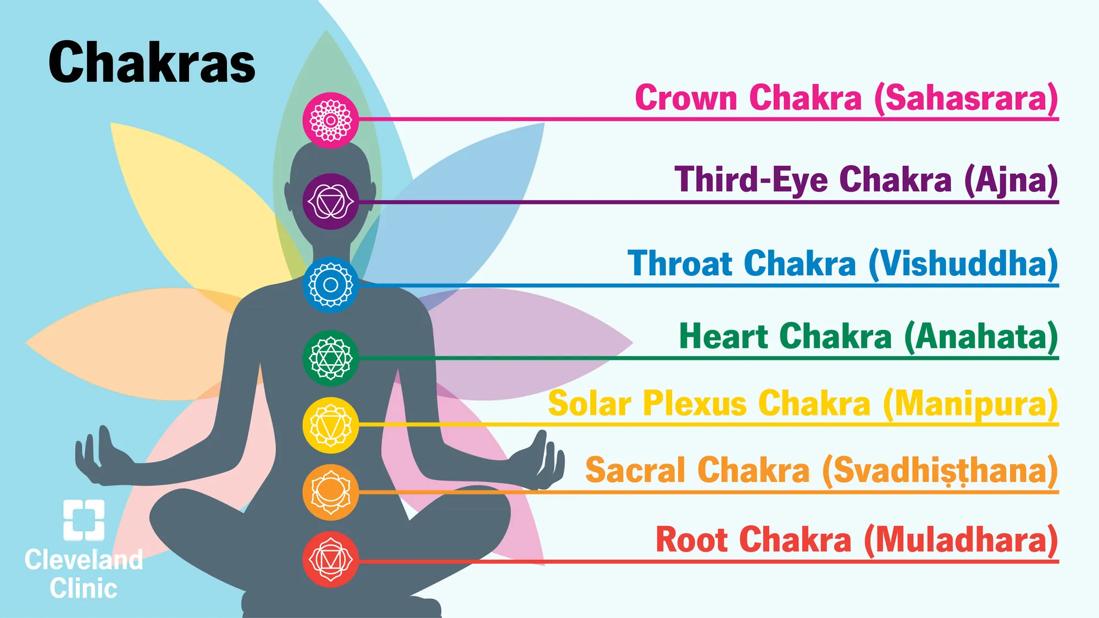Different types of yoga poses, meditation and breathwork may help you feel more emotionally balanced

Chakras refer to seven points along your spine that some people believe are associated with specific physical, emotional and spiritual functions. They’re a part of South Asian traditional systems of medicine and healing. And though chakras aren’t recognized by Western science, they may be a useful metaphor for helping find balance and greater levels of health and wellness.
Advertisement
Cleveland Clinic is a non-profit academic medical center. Advertising on our site helps support our mission. We do not endorse non-Cleveland Clinic products or services. Policy
Many people find value in practices like relaxation, mindfulness and personal development that are said to “balance” the chakras. In that way, you can think about chakras sort of like prayer: Though there’s no scientific evidence that they “work,” they may help you feel centered and bring you peace of mind.
Yoga therapist Renee Warren, C-IAYT, RYT 500, explains what chakras are and what focusing on them could do for you.
The word “chakra” itself is based on the Sanskrit word for “wheel” or “circle,” and the concept has origins in both the Hindu and Buddhist faiths. The seven chakras are said to represent energy sources throughout your body. Each chakra corresponds to:
If you’ve ever taken a yoga class, you might have heard chakras mentioned in relation to certain poses or practices. In yoga terminology, prana (energy) travels through your body between chakras in the nadi (energy channels).
“Each chakra aligns with several yoga poses, or asanas, as well as affirmations or statements of reflection that are thought to help bring balance to that area of the body,” Warren explains.
You may hear chakras referred to by other their Sanskrit names or the English translations. We’ve shared both here.
Advertisement

Location: Bottom of your tailbone
Color: Red
Element: Earth
Affirmation: “I’m safe with myself.”
Emotions: The root chakra is associated with feelings of groundedness, stability, safety and security. If it’s out of balance, you may feel unstable or like you can’t find your footing.
Yoga poses: Standing poses, like:

Location: Between your tailbone and belly button
Color: Orange
Element: Water
Affirmation: “I move with the flow of life.”
Emotions: A balanced sacral chakra contributes to feelings of creativity and playfulness, while a lack of balance may bring feelings of powerlessness or low energy.
Yoga poses: Wide leg and hip opening poses, like:

Location: Belly button area
Color: Yellow
Element: Fire
Affirmation: “I choose what is right for me.”
Emotions: This chakra is associated with feelings of interpersonal power and connectedness. But out of balance, it’s associated with feelings of disempowerment and disconnectedness.
Yoga poses: Poses featuring twists, like:

Location: Center of your chest
Color: Green
Element: Air
Affirmation: “I love and honor myself.”
Emotions: A balanced heart chakra is believed to be connected to feelings like acceptance, compassion and pleasure, while an out-of-balance heart chakra is related to feeling alone, separated and even worthless.
Yoga poses: Poses that include gentle back bends and lateral bends, like:

Location: Pit of your throat
Color: Blue
Element: Space
Affirmation: “I speak freely and confidently.”
Emotions: This chakra is associated with feelings of confidence, truthfulness and boldness. It’s said that if it’s out of balance, you’ll feel fearful and muted, like you don’t have a voice or a say.
Yoga poses: Poses that stretch your neck, like:

Location: Between your eyebrows
Color: Indigo
Element: Light
Affirmation: “I listen to my deepest intuition.”
Emotions: A balanced third eye chakra is associated with clarity and intuitiveness, while out of balance, it’s related to confusion and misperception.
Yoga poses: Poses that are thought to help you enhance your intuition, like:

Location: Top of your head
Color: Purple
Element: None
Affirmation: “I am connected to all things.”
Emotions: A balanced crown chakra is associated with feeling peaceful, illuminated and free. Out of balance, it brings confusion, joylessness and a feeling of being trapped.
Advertisement
Yoga poses: Poses that engage or stimulate the top of your head, like:
Balancing your chakras means figuring out how to foster the positive emotions associated with each one. To figure out what that might look like for you, Warren suggests paying attention to the parts of your life or personality that feel like they’re out of whack.
“Ask yourself: What makes you feel grounded versus scattered? Calm versus stressed?” she poses. “Once you’ve figured out what feels ‘off,’ you can take the time and care to even things out.”
If, for example, you notice that you’re feeling disconnected or isolated, focusing on your heart chakra — like through a chakra-specific affirmation, activity or exercise — may help you meditate on those feelings.
Warren shares a few ways to focus on your chakras.
Balance is an integral part of yoga — and not just physically. Sure, it’s associated with building muscle strength and flexibility, but it’s also an emotional and even spiritual experience for many people.
When reading the yoga poses associated with each chakra, you may have noticed some overlap. That’s because all parts of the body are so deeply interconnected. You can’t move one part without affecting another.
Advertisement
“There’s no pose that impacts only one part of the body,” Warren states. “So, if you focus your yoga movements on one chakra, you’ll feel benefits across other parts of your body, too.”
In general, breathing techniques help you focus on inhaling and exhaling, allowing you to feel calmer and more relaxed.
One specific breathing technique, alternate nostril breathing, is said to balance the flow of energy throughout your chakras. Though there’s no scientific evidence to confirm that, this type of breathwork has been shown to help relieve stress and increase alertness.
“Consciously focusing on your breath can help you feel more present, grounded and balanced,” Warren says. “It also helps your body regulate its stress response.”
Reciting positive affirmations that you find meaningful can help boost your confidence and combat self-doubt. To do chakra-specific affirmations, focus your thoughts on a specific area of your body while repeating the affirmation related to that chakra.
“Whether you repeat it aloud or in your head, just notice what arises and how it makes you feel,” Warren advises.
To do chakra meditation, focus on a particular area of your body while you meditate. Then, try associating that area of your body with the color related to that chakra. For example, if you’re focused on your root chakra, think about your tailbone and picture a bright red light or circle emanating from that area.
Advertisement
“Home in on that area and the color associated with it,” Warren suggests. “Notice what you’re feeling and take a big breath in, with the intention of letting go of any tension.”
Like other forms of meditation, this may take some practice, so don’t feel discouraged if it doesn’t click for you right away.
In the end, focusing on your chakras is all about seeking balance between your mind, body and soul. Though Western medicine doesn’t recognize the idea of chakras or ways to “balance” them, it does recognize the value in practices like yoga, meditation and breathwork — and, in general, focusing on whole-body health.
“If we neglect some part of our life, body or behavior, it will reflect in our overall health,” Warren says. “Our bodies are one integrated system. Everything works together.”
Learn more about our editorial process.
Advertisement

Breathing, exercise, mindfulness and more can help you unwind and step away from your stress

From breath meditation to yoga nidra, all types of meditation aim to help you feel calmer, more relaxed and present

Sensory deprivation therapy can help relieve stress, improve sleep and decrease physical pain

You don’t need to have years of experience to reap the rewards of meditation — with benefits for your whole body, you only need a couple minutes to get started

While walking, be mindful of your body, your mind, your place in the world and all five of your senses as you pave a path forward, one step at a time

Thunder, waterfalls and heavy rain — these low-frequency sounds might help cancel out disruptive noises and thoughts

Immersing yourself in nature can improve both your mental and physical health

This bedtime exercise can help you fall asleep faster (and stay asleep)

The ‘sunshine vitamin’ is found naturally in some fish and is added to other foods

Autism and ADHD often go hand in hand, giving rise to the term AuDHD

The Yuzpe regimen is less effective than other forms of emergency contraceptives, and it’s associated with more side effects